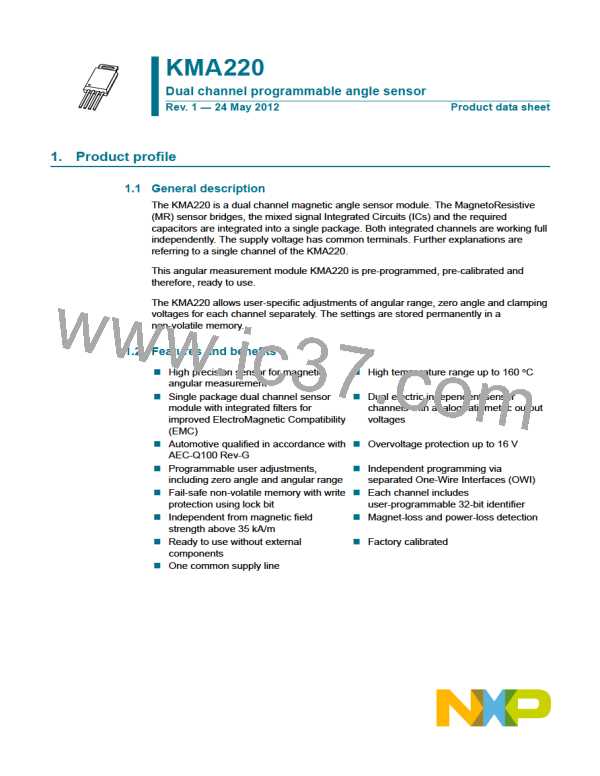KMA220
NXP Semiconductors
Dual channel programmable angle sensor
5. Functional description
Each channel of the KMA220 amplifies two orthogonal differential signals from MR sensor
bridges and converts them into the digital domain. The angle is calculated using the
COordinate Rotation DIgital Computer (CORDIC) algorithm. After a digital-to-analog
conversion, the analog signal is provided to the output as a linear representation of the
angular value. Zero angle, clamping voltages and angular range are programmable.
In addition, two 16-bit registers are available for customer purposes, such as sample
identification.
Each channel of the KMA220 comprises a Cyclic Redundancy Check (CRC) and an Error
Detection and Correction (EDC), as well as magnet-loss to ensure a fail-safe operation.
If either the supply voltage or the ground line of the mixed signal IC is interrupted,
a power-loss detection circuit pulls the analog output to the remaining connection.
After multiplexing the two MR Wheatstone bridge signals and their successive
amplification, the signal is converted into the digital domain by an Analog-to-Digital
Converter (ADC). Further processing is done within an on-chip state machine. This state
machine controls offset cancelation, calculation of the mechanical angle using the
CORDIC algorithm, as well as zero angle and angular range adjustment. The internal
Digital-to-Analog Converter (DAC) and the analog output stage are used for conversion of
the angle information into an analog output voltage, which is ratiometric to the supply
voltage.
The configuration parameters of each channel are stored independently in a
user-programmable non-volatile memory. The OWI (accessible using pin OUTn/DATAn) is
used for accessing the memory. In order to protect the memory content a lock bit can be
set. After locking the non-volatile memory, its content cannot be changed anymore.
5.1 Angular measurement directions
The differential signals of the MR sensor bridges depend only on the direction of the
external magnetic field strength Hext, which is applied parallel to the plane of the sensor.
In order to obtain a correct output signal, exceed the minimum saturation field strength.
KMA220
All information provided in this document is subject to legal disclaimers.
© NXP B.V. 2012. All rights reserved.
Product data sheet
Rev. 1 — 24 May 2012
4 of 36

 NXP [ NXP ]
NXP [ NXP ]